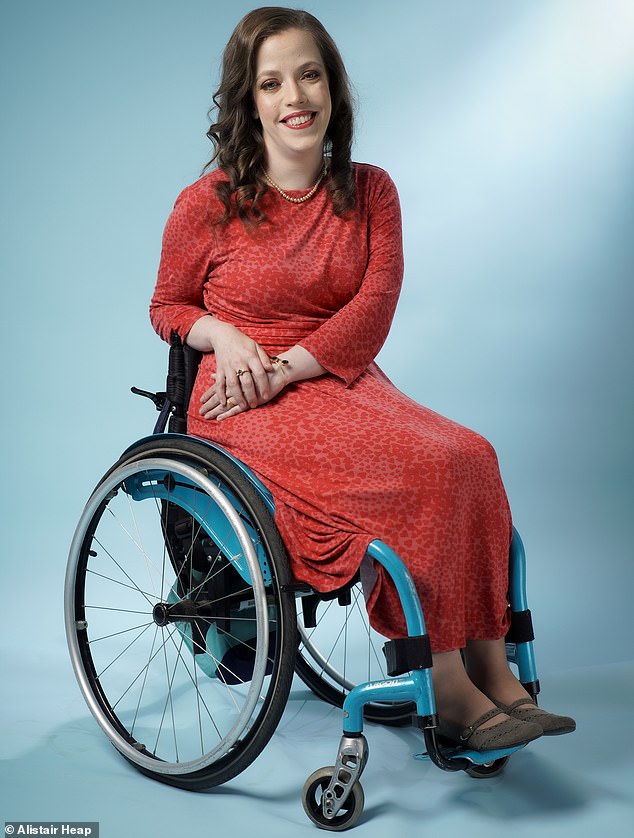Six rules for living with chronic pain and illness: The inspiring vision of GRACE QUANTOCK who has spent 20 years in a wheelchair and suffers 16 conditions

Can you ever live well when you’re suffering from chronic illness? It’s a question I’m perhaps more qualified to answer than some.
Aged 37, I’ve had no fewer than 16 separate diagnoses of illnesses, among them several autoimmune conditions, agonising endometriosis, hemiplegia (causing me intense muscle weakness down my right-hand side) and severe osteoporosis. I’ve needed to use a wheelchair since I was 18.
Some illnesses, including a couple of autoimmune conditions, were diagnosed in my teens, but others came later. The endometriosis first emerged when I was 13 but was not diagnosed until I was 36; I developed hemiplegia when I was 27.
I’ve spent a significant amount of time bedbound, not knowing whether I’d ever be able to leave my room.
At one point, 16 years ago, at my sickest from a barrage of symptoms, a friend who is a paramedic visited me. She left crying because she thought I was dying. I was one of the illest people, she later told me, that she’d ever seen.

The reality of living with chronic illness in the UK is far from the simplistic image of aiming for ‘healing’ which proliferates certain corners of social media, writes GRACE QUANTOCK
Years of my life have been spent navigating hospital appointments, different treatments and extensive medication. I currently take around 30 tablets a day, some to tackle the side-effects of the medications for my various conditions. And every new diagnosis has brought fresh and complex emotions.
For example, the relief I felt aged 21 when doctors told me I did not have sarcoma (a type of bone cancer), which they feared was all through my body, was short-lived, as I was then informed I had osteoporosis.
It was so bad that they’d initially thought the gaps it had caused in my bones, from my ankles to my spine, were tumours.
At the time, I’d been preparing to start a much desired doctorate in history, having been fast-streamed from my degree in the subject. Now life seemed irreparably changed.
Growing up, I’d never seen examples of people living with illness beyond tragedies, miracle cure stories or tales about ‘brave sufferers’. The reality of living with chronic illness in the UK – where there are 16 million disabled people – though is very different, far from the simplistic Instagram image of aiming for ‘healing’ which proliferates certain corners of social media.
However, I’ve found some practical steps can lessen the impact of living with chronic illness and mean we can all live well – even if our conditions can never be cured.

If you record your diagnosis appointment on your phone (with your doctor’s permission, of course), it allows you to listen back later, in case you’ve missed anything
USE PRECISE LANGUAGE WITH YOUR DOCTOR
The first step to any diagnosis is usually through your GP – and you should always use precise language at your appointment. You don’t need to be melodramatic but you do need to be accurate.
So, if you have pain, for instance, plan your description in advance. Saying ‘I have a pain in my stomach’ is not as helpful as saying ‘I have sharp, intermittent pains in my abdomen on the left side about four inches from my hip. I have been having these for two weeks, day and night.’
Describe the pain: is it sharp or dull? Constant or intermittent? Stabbing or pulling? Shooting or throbbing? Burning or cramping?
And describe the effect the pain has on you. Are you unable, or do you find it difficult, to walk, or concentrate, or bend, or travel, or exercise, or sleep, or eat, for instance?
NHS clinical nurse specialist Jenny Davies, based in Wales, gave me valuable insight here – most interestingly, perhaps, that reeling off a long list of varied symptoms isn’t helpful. ‘If you bombard your GP with all of the things you’re experiencing, many will switch off – they’re not going to listen to you or take you seriously,’ she told me. ‘And if you “awfulise” everything, they’ll glaze over.
‘You have to pinpoint the biggest problem, and talk about that as accurately as possible. Doctors are scientists, they want definites, so we need to do our best to give them [that], for our own sake.’
On that note, continuity with your doctor is key. Sometimes it’s better to wait longer, if you can, to see your regular GP than see someone new and have to explain all over again – and who might miss all the experience and non-verbal cues a regular GP would recognise in you.
RECORD APPOINTMENTS
When a doctor tells you what is wrong, it can feel like a cut and dried case. But if you record your diagnosis appointment on your phone (with your doctor’s permission, of course), it allows you to listen back later, in case you’ve missed anything. There’s often a lot to take in.
Finding out you are really sick can be a shock. I’ve taken to carrying essential oil scents I find soothing to diagnosis appointments (I like rose oil).
One 2009 study published in the journal Natural Product Communications found rose oil helped lower blood pressure, heart and breathing rates and cortisol levels.
TRY TO HAVE A ROUTINE
There’s great power in a routine: a simple one can give shape to days that feel endless. So time your meals, set aside periods to talk to friends, set a moment in your day to re-engage with your feelings – practise deep breathing, write in a journal – and see if anything’s changed.
MAKE A FLARE DAY PLAN
Aged 27, I was diagnosed with hemiplegia, caused by a neurological event doctors said it was best to think of as being comparable to a mini-stroke. As a result, I suffer with hemiplegic migraine – where I have the intense headaches, but also intense muscle weakness on my right-hand side.
The longer between migraine attacks, the more I can recover my physical strength.
But when a migraine strikes, it’s virtually like a stroke again afterwards. I cannot squeeze a lip balm or grip a pen – and this can sometimes last for days. One day, I was at a train station trying to use a cash machine – only to realise the touchscreen wouldn’t register the touch of my finger because my muscles had been so weakened by a recent intense hemiplegic attack.
The emotional impact of not being able to do this simple task was, understandably, enormous.
My endometriosis can cause bad pain too. On days when a symptom is overwhelming, I’ve come to rely on my ‘flare day plan’. Without it, I found when a symptom flare happened I was starting from scratch – searching for the extra-strong pain meds, for example, and the big heating pad, which is very useful for the pain.
I know when you want so much to be well that you want to enjoy your good spells, rather than spending them prepping for difficult times. But having a system in place can help.
For example, if you need a particular medicine at a special dosage for bad days – perhaps it’s CBD oil or anti-inflammatories or opiates such as co-codamol when endometriosis pain flares – then make sure you always have a stock.
If you find you use three recipes regularly when sick, because they’re easy to throw together and digest, make sure you have a stockpile of ingredients in.
Enlist friends and relatives and make a list so they know what to do: whether it’s providing snacks, or helping set up an auto-responder on your emails to let people know you’ll take time to reply, or putting your cat’s food in the automatic feeder (buy online for under £10) so they’re fed for the next few days if you have to stay in bed, or asking the pharmacy to deliver your meds.
And be prepared for the possibility that the moment the symptoms start to fade from a relapse, this can, ironically, be more difficult than being really ill. You realise how sick you were and have to cope with the trauma of that.
Plus, real life starts to peek in. You realise you still have a job, or other responsibilities, that have fallen by the wayside. Just be aware that these transition periods aren’t easy, and allow yourself time to heal.
DITCH THE DUVET COVER
Aged 20, not long after I married my lovely husband, Linus, I had a spell of feeling particularly unwell. Already in a wheelchair, I was so bombarded with symptoms from my various conditions that my energy levels were at an all-time low. One of my bugbears at this time was wrestling with bedsheets and changing duvet covers.
The strength and agility required to do this task may seem simple when you are fit and well – but it’s a very different story when you’re chronically ill. Indeed, I know this is an issue for many with chronic illnesses, including the elderly, those with joint pain, or enduring treatments like chemotherapy.
Eventually, I just gave up and instead used a rotation of sleeping bags, inspired by camping trips I’d gone on with my parents. Some bags can fit in your washing machine – plus, they’re so much warmer than duvets. You can even get double-size bags.
On the subject of beds, around this time my district nurse tried to help by giving me a single-size pressure-relief mattress – something I needed to avoid pressure sores. But when placed on our double bed, this left my husband with a slither of space beside me.
When I asked for a double-size pressure mattress, she replied that she’d never ‘seen anyone as sick as you sleep with anyone else’. I pointed out we had just got married – and besides, did she want him to sleep downstairs where I wouldn’t be able to ask him for help if I needed it?
Eventually, we were provided by the NHS with a double-sized pressure-relief mattress. They do exist – so don’t struggle on without one if you spend a lot of time in bed because of illness but still want to feel the warmth and comfort of your partner beside you.
Indeed, I’ve probably spent a lot of time in bed. With that in mind, I spent all our wedding money on antique French bed linen and the best mattress I could find. Why? Well, if the bed was where I was going to live, where my partner and I would spend time, connect and (in my case) eat, sleep, think, see medical professionals and more, I wanted to make it the best space ever.
So much equipment people need when they are bedbound – such as hoists, commodes and sliding sheets (slippery cloths to make it easier to move a sick and immobile person) – are not made with aesthetics in mind.
But visuals matter. This isn’t just our healing environment, it’s our home. It should be both functional and beautiful.
DON’T GIVE UP ON YOUR DREAMS
Sometimes, as we try to survive, we let pieces of our dreams go. Sometimes we listen to people who aren’t qualified give us advice (like my social worker who said I was so sick, no one would ever pay me for anything – but a year later, in 2011, I launched my own business as a wellness coach and then trained as an integrative psychotherapeutic counsellor specialising in complex bodies, trauma and lives).
We often put off dreams until we can do them ‘properly’ or how we first imagined they would be. But living our dreams doesn’t mean living in a fantasy land – it can mean adapting and shaping and creating our life.
I’d like to learn Italian and to do ballet. Are these still possible? Of course, I’m not about to turn up to the Royal Ballet School, but I have a ballet DVD and found a local teacher who dances in an integrated ballet company with disabled and non-disabled dancers. I do adapted versions of the dances sitting down and using my arms. It’s wonderful physio, too – strengthening my muscles and distracting me from the pain.
And I may not be up to going to live in Florence for six months but I can practise French and Italian with my grandmother, who also loves languages.
There is always, in my experience, a way to access joy. For example, say you love dangling your toes in the ocean, and feeling the sea air clearing your lungs, there are companies who hire out beach wheelchairs that can traverse the sand.
I used one at Swansea and went adaptive surfing with Surfability UK, a company that provides surfing lessons for those with disabilities or illness, which helped me see I didn’t need to wait for a fabled ‘recovery’ to do the things I love. I just needed to find places that are accessible and inclusive!
- Adapted from Living Well With Chronic Illness by Grace Quantock (Orion Spring, £18.99). © Grace Quantock 2024. To order a copy for £17.09 (offer valid to 23/09/24; UK P&P free on orders over £25) go to mailshop.co.uk/books or call 020 3176 2937.




